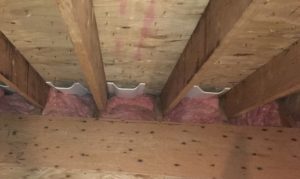Boston Metrowest, MA – Improve Airflow and Minimize Mold with Ventilation
Posted in: Client Examples
Let’s Talk About Airflow
In a previous blog post, we talked about how attics and how they are susceptible to mold, especially during the summer months. With the previous post in mind, we want to focus on one of the most important ways you can prevent mold from growing. Airflow. It feels nice on the skin, cools you down, and creates a beautiful sound when running over the leaves in the trees. Unlike us and our need and want of airflow during the hot and humid summers, airflow is actually detrimental to mold and mold growth. Just as moving air rustles and bustles the leaves on trees and carries the smell of those summer flowers to planted a week ago, airflow disrupts mold from growing by disrupting the spores from settling. By having a proper ventilation system which administers proper airflow, mold is less likely to grow. So, how? What is the first step to achieving proper ventilation for our attics? Vents. There are two types of vent we will be looking at, intake vents and exhaust vents.
Intake Vents
The ventilation system starts with the intake vent. The purpose of the intake vent is to bring new, cool air from the outside into the attic. The new air, which is moving rather than sitting, moves the air inside of the attic and disrupts mold from growing. Not only does the new air disrupt the spores from growing, it also assists the exhaust vent which we’ll talk about in a little bit. There are many types of intake vents to choose from out there. We have listed a few common intake vents to help you find one that fits your style and home!

- Soffit Vent
- Gable Vent
- Venting Drip Edge
- Fascia Vent
- Static Vent.
- Power Vent
Exhaust Vents
In the intake portion of this post, we said that the new, cool air assists the exhaust vent. How? Science! The science of air tells us that hot air rises while cool air tends to stay closer to the ground. When new air enters into the attic via the intake vent, the new cooler air hits the ground running while pushing the old, hot, humid air out the exhaust vent. By pushing the hot, old, humid air out, mold is less likely to grow in the attic. Like with the intake vents, here are a few common vents to help you get started on finding the right exhaust vent(s) for you!
- Ridge Vents
- Roof/Gable Louvers
- Wind Turbines
- Static Vent
- Power Vent
Is It Worth It?
Hands down, yes, and for more reasons than just mold. With a proper ventilation system, your attic will not be as hot and humid to go into. Not only does having an attic with a proper ventilation system make attic mold less likely to happen, having a cooler attic means that being up there is more bearable.
If you suspect mold, you will want to call mold removal professionals, like STOP Metrowest in Framingham MA, to ensure the mold is removed without contaminating other areas of your home. STOP has the most up to date training and equipment to safely and quickly stop the damage from occurring and restoring the area to a safe environment.
STOP Metrowest is an IICRC Certified Firm – safe, quality, and compassionate service is our priority! We provide rapid mold assessment and remediation in Framingham MA or other Metrowest MA communities like Hopkinton MA, Needham MA, and Hudson MA. Call STOP MetroWest at 508-753-3780.
For more information, visit our webpage at STOP Metrowest.
Return to: Boston Metrowest, MA – Improve Airflow and Minimize Mold with Ventilation
Social Web